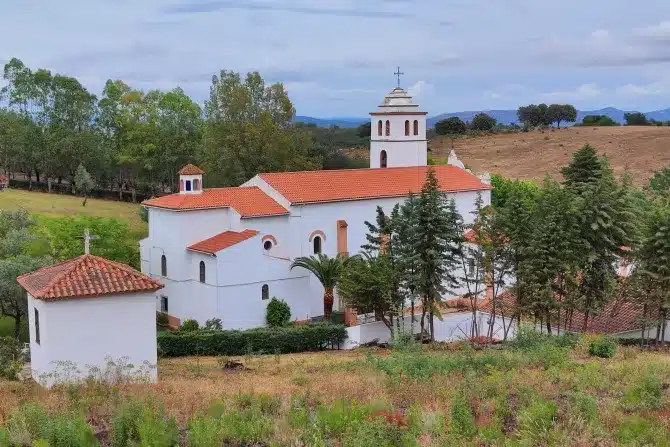The Vatican has approved the devotion to the Spanish Marian shrine of Our Lady of Sorrows of Chandavila where the Virgin Mary reportedly appeared to two young girls at the end of World War II.
A 22 August <a href="https://www.vatican.va/roman_curia/congregations/cfaith/documents/rc_ddf_doc_20240822_lettera-chandavila_en.html"><mark style="background-color:rgba(0, 0, 0, 0)" class="has-inline-color has-vivid-cyan-blue-color">letter</mark></a> from the Dicastery for the Doctrine of the Faith (DDF) accepts the decree of Archbishop José Rodríguez Carballo of Mérida-Badajoz approving the spiritual activities at the shrine in the village of La Codosera, located in western Spain’s lesser known Extremadura region that borders Portugal.
The letter,<strong> </strong>entitled "A light in Spain" and signed by DDF prefect Cardinal Víctor Manuel Fernández and approved by Pope Francis in an 22 August audience, states that “this Dicastery readily grants its consent for you to proceed with the declaration of the proposed '<em>nihil obstat</em>'", so that “the Shrine of Chandavila—which is an heir to a rich history of simplicity, few words, and yet much devotion—may continue to offer to the faithful who wish to approach it, a place of interior peace, consolation, and conversion.”
Devotion to Our Lady of Sorrows of Chandavila is based on the reported appearances of the Virgin Mary shortly before the end of World War II in 1945 to two young Spanish girls, 10-year-old Marcelina Barroso Expósito and 17-year-old Afra Brígido Blanco. The appearances took place where the shrine now stands in the village of La Codosera, right by the border with Portugal.
It is recounted that the girls could not but notice that Mary's beautiful face bore every mark of deep pain and overwhelming sadness when she appeared to them.
The DDF letter notes: “Marcelina recounts that, at first, she saw a dark shape in the sky. At other times, it became more apparent that this shape was the Virgin of Sorrows, with a black mantle full of stars, on a chestnut tree. More than the vision itself, this girl had the profound experience of feeling the embrace and the kiss that the Virgin gave her on the forehead.
“This call of the Virgin, to trust in her love, gave this poor and suffering girl hope, and also the experience of feeling dignified."
It also says that “it was an experience of beauty because the Virgin appeared surrounded by luminous constellations, like those that could be admired at night in the clear sky of the small villages of Extremadura, Spain.”<br><br>Extremadura is one of Spain's least populated and poorest regions. Its desolate wide open plains toward the centre of the region are where many of the country's bulls are reared.
There is a haunting beauty and an intimidatingly brutal type of splendour to Extremadura’s arid vistas and open spaces. The somewhat infamous – due to its length and toughness – <em>Via de la Plata</em> Camino pilgrimage passes northward through the region on its way from Seville in the region of Andalusia, to Extremadura's south, all the way to Santiago de Compostela 1,000 kilometres farther on in northwestern Galicia.
<strong><em>RELATED: <a href="https://catholicherald.co.uk/the-thirstiest-camino-of-them-all/"><mark style="background-color:rgba(0, 0, 0, 0)" class="has-inline-color has-vivid-cyan-blue-color">The thirstiest Camino of them all</mark></a></em></strong>
The DDF notes that “after the alleged visions, the two girls led a discreet and inconspicuous life" and "both dedicated themselves to works of charity, especially to caring for the sick, the elderly, and orphans, thereby transmitting to those who are suffering the sweet consolation of the Virgin’s love that they had experienced.”
It also highlights: “Many positive aspects indicate an action of the Holy Spirit in so many pilgrims who come, both from Spain and Portugal, in the conversions, healings, and other valuable signs in this place.”
While the Vatican dicastery did not make a ruling about the nature of the apparitions themselves, it concludes: “There is nothing one can object to in this beautiful devotion, which presents the same simplicity that we can see in Mary of Nazareth, our Blessed Mother.”<br><em><br><strong>RELATED: <a href="https://catholicherald.co.uk/camino-conflagration-blamed-on-badly-behaved-pilgrims/?swcfpc=1"><mark style="background-color:rgba(0, 0, 0, 0)" class="has-inline-color has-vivid-cyan-blue-color">Devotion to two Marian appearances approved by Vatican as ‘signs of grace and spiritual conversion’</mark></a></strong></em><br><strong><br><em>RELATED: <a href="https://catholicherald.co.uk/vatican-approves-devotion-to-indias-16th-century-vailankanni-marian-shrine/?swcfpc=1"><mark style="background-color:rgba(0, 0, 0, 0)" class="has-inline-color has-vivid-cyan-blue-color">Vatican approves devotion to 16th-century Vailankanni Marian shrine in India</mark></a></em></strong>
<em>Photo: The shrine of Our Lady of Sorrows of Chandavila in the village of La Codosera, Etremadura, Spain. (Credit: Mentxuwiki/Wikimedia.)</em>



